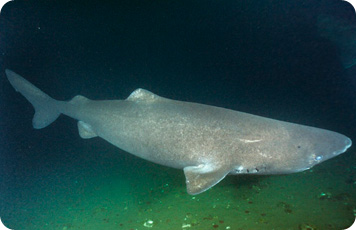The Greenland shark already has several aliases -- sleeper shark, ground shark, and others. But another good one might be the “wrong-way” shark. While other sharks head for warmer waters during winter, the Greenland shark heads for colder waters. It rises toward the surface, where water temperatures drop to near freezing -- several degrees colder than the deeper layers it inhabits during summer.
 Greenland sharks can live in near freezing water. Credit: Andy Murch, Elasomdiver www.elasmodiver.com
Greenland sharks can live in near freezing water. Credit: Andy Murch, Elasomdiver www.elasmodiver.comThe Greenland shark is found mainly in the North Atlantic, from New England and Canada across to Scandinavia -- farther north than any other shark.
But it’s well adapted for life in its cold home. Unless it’s grabbing a meal, it conserves its energy by moving slowly. Eating can be a low-energy activity, too, because it often feeds on dead fish. And it doesn’t put much energy into getting bigger, either: Once it reaches adulthood, it grows less than an inch a year.
Even so, the Greenland shark can grow to 15 to 20 feet long, and weigh half a ton or more. Because of that great size and slow growth rate, researchers believe the sharks may live for a century, or even two.
During the early 20th century, Greenland sharks were caught for the oil in their large, fatty livers -- perhaps as many as 50,000 of them a year. But they weren’t taken for their meat. Their flesh is filled with compounds that make it taste bad. And unless the meat is dried or repeatedly boiled, it can make you drunk.
But perhaps that’s not too surprising for a creature that always seems headed in the wrong direction.

